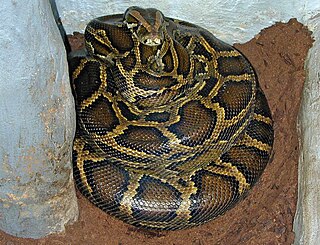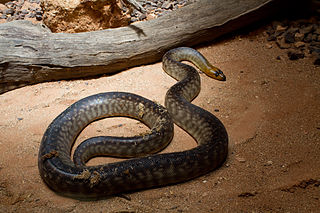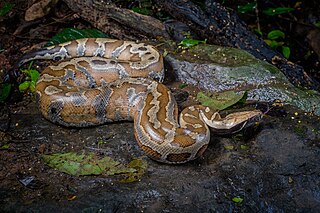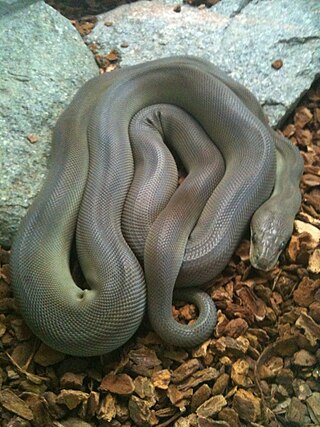
The reticulated python is a python species native to South and Southeast Asia. It is the world's longest snake, and the third heaviest after the green anaconda and Burmese python. It is listed as least concern on the IUCN Red List because of its wide distribution. In several countries in its range, it is hunted for its skin, for use in traditional medicine, and for sale as pets. Due to this, reticulated pythons are one of the most economically important reptiles worldwide.

The ball python, also called the royal python, is a python species native to West and Central Africa, where it lives in grasslands, shrublands and open forests. This nonvenomous constrictor is the smallest of the African pythons, growing to a maximum length of 182 cm (72 in). The name "ball python" refers to its tendency to curl into a ball when stressed or frightened.

The Burmese python is one of the largest species of snakes. It is native to a large area of Southeast Asia and is listed as Vulnerable on the IUCN Red List. Until 2009, it was considered a subspecies of the Indian python, but is now recognized as a distinct species. It is an invasive species in Florida as a result of the pet trade.

The Green tree Python, is a species of snake in the family Pythonidae. The species is native to New Guinea, some islands in Indonesia, and the Cape York Peninsula in Australia. First described by Hermann Schlegel in 1872, it was known for many years as Chondropython viridis. As its common name suggests, it is a bright green snake that can reach a total length of 2 m (6.6 ft) and a weight of 1.6 kg (3.5 lb), with females slightly larger and heavier than males. Living generally in trees, the green tree python mainly hunts and eats small reptiles and mammals. It is a popular pet, and numbers in the wild have suffered with large-scale smuggling of wild-caught green tree pythons in Indonesia. Despite this, the green tree python is rated as least concern on the IUCN Red List of endangered species.

The spotted python, eastern small-blotched python, or eastern Children's python is a python species found in northern Australia and New Guinea. It is a popular pet among Australian reptile enthusiasts and other reptile enthusiasts abroad due to its small size and even temperament. No subspecies were originally recognized. However, two subspecies were recognized as of 2020; A. m. maculosa and A. m. peninsularis.

The woma python, also known commonly as Ramsay's python, the sand python, and simply the woma, is a species of snake in the family Pythonidae, endemic to Australia. Once common throughout Western Australia, it has become critically endangered in some regions.

Morelia spilota cheynei, or the jungle carpet python, is a python subspecies found in the rainforests of Queensland, Australia.

Morelia bredli is a species of non-venomous snake in the family Pythonidae. The species is endemic to Australia. No subspecies are recognized. Its common names include Bredl's python, the Centralian python, the Centralian carpet python, the central Australian carpet python, Bredl's carpet python, the central Australian Bredl's carpet python, and the central Bredl's carpet python.

The amethystine python, also known as the scrub python or sanca permata in Indonesian, is a species of non-venomous snake in the family Pythonidae. The species is found in Indonesia and Papua New Guinea. Popular among reptile enthusiasts, and noted for its coloration and size, it is one of the largest snakes in the world, as measured either by length or weight, and is the largest native snake in Papua New Guinea. Until 2000, the larger S. kinghorni was generally considered a subspecies of S. amethistina, and this change of classification has still not been universally reflected in literature. Because of this issue, S. amethistina has often been described as the largest snake in Australia, but this is not accurate since under the current classification, this species does not occur in Australia.

The rough-scaled python is a large-scaled python species endemic to Australia. No subspecies are currently recognized.

Python brongersmai is a species of nonvenomous snake in the family Pythonidae. The species is native to Southeast Asia.

Morelia spilota spilota is a subspecies of carpet python, popularly known as the diamond python. It is a medium to large snake, found in coastal areas and adjacent ranges of south-eastern Australia. It is the most southerly occurring python in the world and is found at higher altitudes than any other species of Australian python.

The Timor python is a python species found in Southeast Asia. A dwarf species, no subspecies are recognized as being valid. Like all pythons, it is a nonvenomous constrictor; unlike larger species such as the reticulated python, it is not considered dangerous to humans.

The olive python is a species of snake in the family Pythonidae. The species is endemic to Australia. Two subspecies are recognized, including the nominate subspecies described here.

Liasis mackloti, commonly known as Macklot's python or the freckled python, is a species of python, a non-venomous snake in the family Pythonidae. The species is endemic to Indonesia, East Timor, Papua New Guinea, and coastal northern Australia. Three subspecies are recognized, including the nominate subspecies described here.

Simalia tracyae, the Halmahera python, is a species of python found only on the Indonesian island of Halmahera. It belongs to the family Pythonidae and the genus Simalia. This snake was previously believed to have belonged to the Simalia amesthistina species; however, studies in recent years have caused scientists to distinguish between the two types of snakes, resulting in the reclassification of the Halmahera python as its own species.

The Australian scrub python, or simply scrub python is a species of snake in the family Pythonidae. The species is indigenous to forests of northern Australia. It is one of the world's longest and largest snakes, and is the longest and largest in Australia. Recently, it has been reclassified to the genus Simalia alongside a few other former Morelia species, but scientific debate over this continues.

Tracy Jo Barker is an American herpetologist specializing in pythons.

















